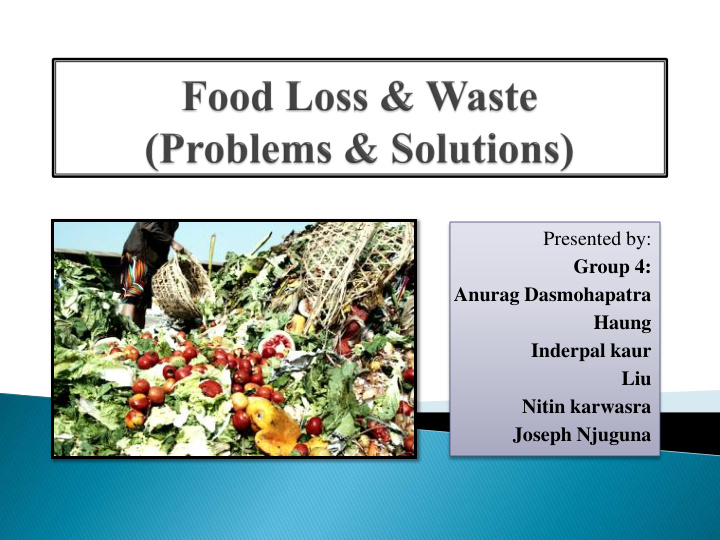



Presented by: Group 4: Anurag Dasmohapatra Haung Inderpal kaur Liu Nitin karwasra Joseph Njuguna
INTRODUCTION 1. According to FAO, almost one-third of food produced for human consumption – approximately 1.3 billion tonnes per year, is either lost or wasted globally. 2. The issue of food losses is an high alert situation for the efforts to counter hunger, elevate income and ameliorate food security especially in the world’s poorest countries. 3. Food losses have an humongous impact on food security for poor people, on food quality and safety, on economic development and on the environment.
DEFINITION Food loss is defined as “the decrease in quantity or quality of food” and are the agricultural or fisheries products intended for human consumption that are ultimately not eaten by people or that have incurred a reduction in quality reflected in their nutritional value, economic value or food safety. Food waste, refers to the discarding or alternative use of food that was fit for human consumption, by choice or after the food has been left to spoil or expire as a result of negligence .
TYPES OF FOOD LOSSES / WASTE • Animal commodities and products • Vegetable commodities and products Further classified into - 1. Agricultural production 2. Post – harvest handling and storage 3. Processing 4. Distribution 5. Consumption
PROBLEMS 1. Risk of decreasing food security and nutritional quality 2. Due to food loss increased methane production and increased global warming 3. Increased water pollution due to mixing up off the debris due to waste material rotting 4. Increased microorganism growth and fear of new disease incidence 5. Last but not the least , even if we focus on increasing production and quality if we don’t minimize loss/waste nothing is going to change in future.
The destiny of wasted food
Per capita food losses and waste, at consumption and pre-consumptions stages
A gift of nature - principle depends on cooling by evaporation. Efficiency of evaporative cooler depends on humidity of the surrounding air. Very dry, low humidity air can absorb a lot of moisture so considerable cooling occurs. In theory lowest temperature that can be reached is wet bulb temperature. It is a double brick-wall structure, structure, the cavity is filled with sand and walls of the chamber are soaked in water.
It does not require any electricity or power to operate 1. Materials required like bricks, sand, bamboo etc. 2. available easily and cheaply. Even unskilled labour can build the chamber, as it 3. does not require any specialized skill. Small and marginal farmers can store a few days' 4. harvest to avoid middlemen. Cool chambers can reduce temperature by 10-15 ° C 5. and maintain high humidity of about 95% that can increase shelf life and retain quality of horticultural produce.
Source: http://ucce.ucdavis.edu
Generally, tomato and eggplant had a shelf life of 7 and 4 days at room temperature, respectively, as compared to 16 and 9 days when stored in the ZECC. Tomato and eggplant treated with hot water reduced the percentage of rotting. Tomato treated with hot water at 60 ° C for three minutes and eggplant treated with hot water at 45 ° C for an hour when stored inside silver-ion-coated containers in the ZECC showed extended shelf life of up to 28 and 15 days, respectively. Source :https://www.researchgate.net/publication/279974670_Zero_ Energy_Cool_Chamber_for_Extending_the_Shelf- Life_of_Tomato_and_Eggplant
Kale et al. (2016) Low Cost Storage Structures for Fruits and Vegetables Handling in Indian Conditions
Composting Zera food recycler Whirlpool’s Zera Food R Recycl ycler
GADGETS AND GIZMOS THAT HELP REDUCE FOOD WASTE Herb Keeper Phresh Food Protector
Eliminating food waste requires behavioral changes, but GMOs can help too
knock-down LsXTH16 gene would improve lettuce shelf life Short shelf life lettuce Long shelf life lettuce
knock out vacuolar invertase gene (Vinv) could have significantly lower levels of reducing sugars and acrylamide
Reducing Food Loss Close to the Farm Improved storage methods Redistribute food Reducing Food Waste Close to the Fork Better food date labels Reduce portion sizes Launch consumer awareness campaigns
Develop a food loss and waste measurement protocol: Set food loss and waste reduction targets: Increase investment in reducing post-harvest losses in developing countries: Create entities devoted to reducing food waste in developed countries: Accelerate and support collaborative initiatives to reduce food loss and waste:
Prevent and Reduce Food Waste in Your Own Life Spread the Word Volunteer with Local Food Rescue Organizations Start a Food Waste Campaign in Your Community Support Businesses with Good Food Waste Practices Engage with Local Government Tell Your Legislators That Food Waste Is an Important Issue Organize a Food Waste Event in Your Area
Bluapple BluWrap
• Copia • Edipeel • IRRI Super Bag • Smart Packaging • Gebni
With thanks to faculty of Manna Centre
Recommend
More recommend